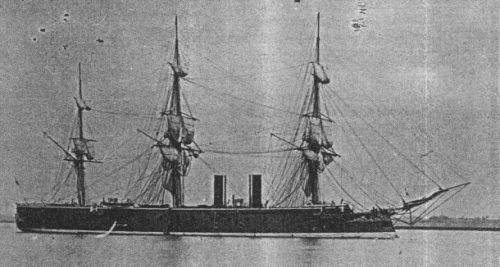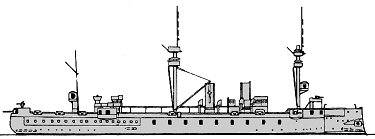
NAVYPEDIA
 Support the project with paypal
Support the project with paypal
Photo

König Wilhelm
Ships
| Name | No | Yard No | Builder | Laid down | Launched | Comp | Fate |
|---|---|---|---|---|---|---|---|
| König Wilhelm (ex-Wilhelm I, ex-Fatikh) | Thames Iron Wks, Blackwall, UK | 1865 | 25.4.1868 | 20.2.1869 | large cruiser 1.1897, harbour ship 5.1904 |
Technical data
| Displacement normal, t | 10591 |
|---|---|
| Displacement full, t | 10761 |
| Length, m | 108.6 wl 112.2 oa |
| Breadth, m | 18.3 |
| Draught, m | 8.56 |
| No of shafts | 1 |
| Machinery | 1 HSE, 8 rectangular boilers |
| Power, h. p. | 8440 |
| Max speed, kts | 14.7 |
| Fuel, t | coal 750 |
| Endurance, nm(kts) | 1300(10) |
| Armour, mm | iron; belt: 305 - 152, battery: 203 - 152, deck: 51, CT: 100 |
| Armament | 18 x 1 - 238/18 RKL/20 C/68, 5 x 1 - 209/20 RKL/22.5 C/68 |
| Complement | 730 |
Standard scale images

König Wilhelm 1870

König Wilhelm 1896
Graphics
Project history
Reed-designed central battery ship, begun as the Turkish Fatikh. While still on the stocks she was purchased for the German Navy, originally under the name Wilhelm I, as an armoured frigate. She was for some time the largest and most powerful ship in the German Navy, and served as flagship.
Ship protection
Main wrought iron belt had 250-90mm wooden back and consisted from upper belt 305mm-thick amidships and 152mm fwd (aft from central battery there was no upper belt) and lower belt 178mm under battery and 127mm fore and aft. Battery had 203mm sides and was protected by 150mm transverse bulkheads. Main CT had 100mm sides and 30mm roof, aft CT had 50mm sides and 30mm roof.
Modernizations
1878-1882: reboilered with 8 rectangular boilers, ram was strengthened.
1880s: - 1 x 1 - 209/20; + 7 x 1 - 149/28 RKL C/88, 4 x 1 - 79/25 RKL/27 C/73, 6 x 5 - 37/27 RV L/30, 5 - 350 TT (2 bow, 2 beam, 1 stern)
1895-1896: - 4 - 209/20, 6 x 1 - 149/28, 4 x 1 - 79/25, 6 x 5 - 37/17; + 4 x 1 - 238/18 RKL/20 C/68, 18 x 1 - 88/27 SKL/30 C/89
Naval service
She was reboilered by Wilhelmshaven Dockyard between 1878 and 1882, as part of a thorough repair after the collision with Grosser Kurfürst, and was also given a stronger ram. In 1895/6 a major rebuild by Blohm & Voss converted her to a heavy cruiser, in the same way as several of her British contemporaries. Her ship rig was reduced to two military masts with fighting tops, and a small mizzen mast was soon removed. The refit could not prevent her from being obsolete, but there was still much life left in the strong old hull, and in 1907, after three years as a harbour ship, she became the school ship of the Naval Academy, with only the sixteen 88mm guns left, reduced by 1915 to only four guns.
 HOME
HOME FIGHTING SHIPS OF THE WORLD
FIGHTING SHIPS OF THE WORLD GERMANY
GERMANY CAPITAL SHIPS
CAPITAL SHIPS KÖNIG WILHELM central battery ironclad (1869)
KÖNIG WILHELM central battery ironclad (1869)
